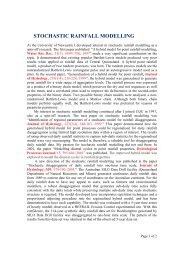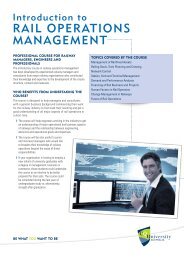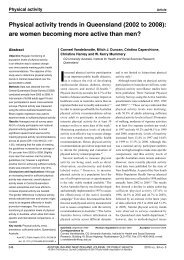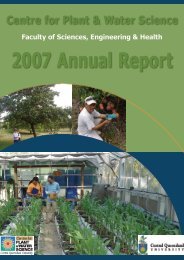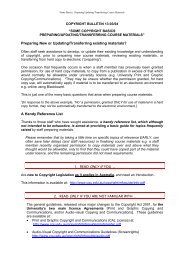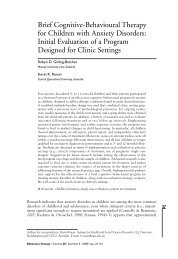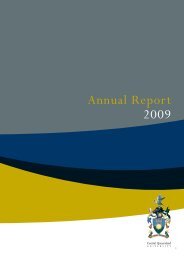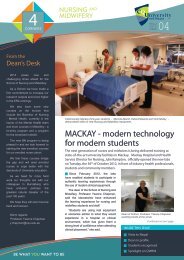CQUniversity Annual Report - Central Queensland University
CQUniversity Annual Report - Central Queensland University
CQUniversity Annual Report - Central Queensland University
- No tags were found...
You also want an ePaper? Increase the reach of your titles
YUMPU automatically turns print PDFs into web optimized ePapers that Google loves.
20<strong>Central</strong> <strong>Queensland</strong> <strong>University</strong>and Controlled EntitiesNotes to the Financial Statementsfor the year ended 31 December 2012(w)New standards and interpretationsIn the current year , the Group adopted all of the new and revised Standards and Interpretations issued by the AustralianAccounting Standards Board (AASB) that are relevant to its operations and effective for the current reporting period. Theadoption of the new and revised Standards and Interpretations has not resulted in any material changes to the Group’saccounting policies and has had a minimal impact on the Group’s financial statements as outlined below.As the Group held no collateral or other credit enhancements in respect of its financial instruments, and did not renegotiatethe terms of any financial assets, during the reporting periods presented in these financial statements, there were no otherchanges required to the Group’s financial instruments note arising from the amendments to AASB 7 Financial Instruments:Disclosures.AASB 1054 Australian Additional Disclosures became effective from reporting periods beginning on or after 1 July 2011.Given the Group's previous disclosure practices, AASB 1054 had minimal impact on the Group. Note 33 regarding auditfees has been slightly amended to clarify the nature of the work performed by the auditor.AASB 2011-1 Amendments to Australian Accounting Standards arising from the Trans-Tasman Convergence Project alsobecame effective from reporting periods beginning on or after 1 July 2011. The only implication for the Group from thisamending standard was the deletion from AASB 101 Presentation of Financial Statements of the requirement for disclosureof contractual expenditure commitments. Group has elected to continue to disclose this information in aggregate in Note35.The following standards, amendments to standards and interpretations have been identified as those which may impact theentity in the period of initial application. They are available for early adoption at 31 December 2012, but have not beenapplied in preparing this financial report.This accounting standard is effective for reporting periods beginning on or after 1 January 2013 and is to be appliedprospectively from that date. AASB 13 establishes a single source of guidance for fair value measurements. The standarddoes not include requirements on when fair value measurement is required but rather prescribes how fair value is to bemeasured and disclosed when it is required by another accounting standard. Many of these disclosures relate to the threelevelfair value hierarchy and are already required for financial instruments under AASB 7. However, AASB 13 extendsthese disclosures to cover all assets and liabilities within its scope. Potential impacts of AASB 13 relate to the fair valuemeasurement methodologies used, and financial statement disclosure made in respect of such assets and liabilities.The <strong>University</strong> has commenced reviewing its fair value methodologies (including instructions to valuers, data used andassumptions made) for all items of property, plant and equipment measured at fair value to determine whether thosemethodologies comply with AASB 13. No significant changes are anticipated based on the fair value methodologiespresently used. Therefore, at this stage, no consequential material impacts are expected for the university’s property, plantand equipment for year ended 31 December 2013.AASB 13 will require an increased amount of information to be disclosed in relation to fair value measurements for bothassets and liabilities. To the extent that any fair value measurement for an asset or liability uses data that is not‘observable’ outside the Group, the amount of information to be disclosed will be relatively greater.AASB 9 Financial Instruments (December 2010) and AASB 2010-7 Amendments to Australian Accounting Standardsarising from AASB 9 (December 2010) [AASB 1, 3, 4, 5, 7, 101, 102, 108, 112, 118, 120, 121, 127, 128, 131, 132, 136,137, 139, 1023 & 1038 and Interpretations 2, 5, 10, 12, 19 & 127] become effective from reporting periods beginning on orafter 1 January 2015. The main impact of AASB 9 is to change the requirements for the classification, measurement anddisclosures associated with financial assets. Under the new requirements, financial assets will be more simply classifiedaccording to whether they are measured at amortised cost or fair value. Pursuant to AASB 9, financial assets can only bemeasured at amortised cost if two conditions are met. One of these conditions is that the asset must be held within abusiness model whose objective is to hold assets in order to collect contractual cash flows. The other condition is that thecontractual terms of the asset give rise on specified dates to cash flows that are solely payments of principal and intereston the principal amount outstanding.The <strong>University</strong> has commenced reviewing the measurement of its financial assets against the new AASB 9 classificationand measurement requirements. However, as the classification of financial assets at the date of initial application of AASB9 will depend on the facts and circumstances existing at that date, the <strong>University</strong>’s conclusions will not be confirmed untilcloser to that time.The following new and revised standards apply as from reporting periods beginning on or after 1 January 2013:AASB 10 Consolidated Financial StatementsAASB 11 Joint Arrangements





